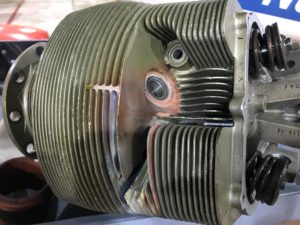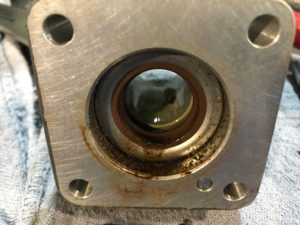Podcast: Play in new window | Download
 This cylinder definitely has a problem! And I can’t help but think, could there have been a way to detect what was going on before it got this severe? I’m not sure, but I do wonder what might have been detected if a borescope inspection had been done at the last annual. (Perhaps that was done, and nothing showed up at that time.)
This cylinder definitely has a problem! And I can’t help but think, could there have been a way to detect what was going on before it got this severe? I’m not sure, but I do wonder what might have been detected if a borescope inspection had been done at the last annual. (Perhaps that was done, and nothing showed up at that time.)
Whatever the case, this cylinder is not healthy. Thankfully, it was found, and removed from that engine. One complicating factor on this airplane, was that the #1 and #5 EGT probes were swapped, which could have caused some confusion.
Another thing I saw in the shop this past week, was an area of blue fuel stain below one of the induction couplings on this Cessna 182. (This is NOT the airplane that had the cylinder problem.)
The induction coupling clamps on this engine needed a little tightening… It’s always a good idea to check these clamps during the annual inspection, both on Lycoming, and Continental engines.
Another good way to check for induction leaks is to do an in-flight induction leak test using different power settings and analyzing information on the engine monitor. (Thank you Steve, for pointing that out.) You can google “Mike Busch induction leak test” for more information on that.
The third item in this week’s episode is about leaking vacuum pump drive seals, commonly known as Garloc seals. This is the seal that keeps engine oil from leaking past the rotating shaft that drives the vacuum pump. When this seal leaks, one indicator can be small oil droplets that are slung around in the area surrounding the vacuum pump.
Here is what this seal looked like when the vacuum pump was removed.
Remember, from last week’s episode, make sure your heating system is in good, safe, working condition. If you have a combustion heater, make sure all checks are up to date, and consider having a pressure test done, even if it’s not “required.”
If your heat is collected from your engine’s exhaust system, make sure it has been thoroughly inspected for any defects that could allow carbon monoxide to enter the cabin. Use a good quality carbon monoxide detector (Not the spot detectors.) Get one that has a visual and audible warning.
Reminder: More information coming soon about Dean’s safety wiring video course, to help airplane owners learn how to do excellent safety wiring, or to help them get better at it.
Fly safely!







Recent Comments